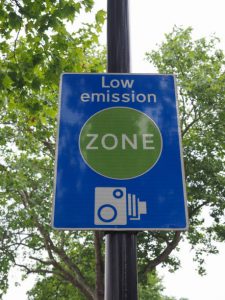
How can clean air zones improve urban areas?
If you’re still driving a petrol or diesel vehicle, it’s important to know about clean air zones and the impact they could have on your driving, especially if you commute frequently. The Ultra Low Emission Zone in London is due to expand from 29th August 2023, and other U.K. cities are introducing their own clean air zones too.
These new regulations might feel frustrating for motorists, but they’re in place for good reason. Whether you need to use them for business or leisure, it’s always worth knowing about the positive impact of clean air zones on the areas they surround.
What are clean air zones?
Clean air zones are road networks linking towns, neighborhoods, and streets that are included within an invisible boundary. Usually indicated by signs and policed by remote cameras, clean air zones dictate where a local authority has put measures in place to improve the air quality.
In 2019, a report by Public Health England estimated that up to 36,000 deaths each year in the UK can be linked to poor air quality.
What do clean air zones do?
The new zones are contributing to healthier environments for residents, visitors, and tourists. By encouraging the use of low- or zero-emission vehicles, harmful emissions are reduced and it’s then possible for local authorities to foster healthier cities.
There are various types of clean air zones, ranked from Class A to Class D. This system dictates which types of vehicles are exempt from the charges incurred. But in any charging zone, drivers need to pay a fee to drive through the clean air zone area. Generally, the higher the emissions from a vehicle, the higher the charge in a clean air zone will be.
Do clean air zones work?
Yes. There is evidence that clean air zones contribute to cleaner air by reducing harmful pollutants, including nitrogen oxide (NO), carbon monoxide (CO), and particulate matter.
London’s ultra-low emission zone, or ULEZ, started in 2017. Just five years later, by October 2022, nitrogen dioxide levels from traffic had been reduced by 46% and by 21% in the city center.
Despite criticism, diverting traffic does not make pollution levels worse outside of the clean air zones. Instead, these initiatives simply encourage drivers to use more sustainable transport methods, buy a new electric vehicle, or purchase used cars that fit the criteria for ULEZ compliance.
How can sustainable transport be promoted?
- Encouraging cleaner commutes
Through clean air zones and efforts from employers, staff can be incentivized into using eco-friendly transport options. Encouraging employees to take up cycling and walking instead of private vehicles could make a significant difference over time.
- Building greener cities
The collaboration between governments, local authorities, and the communities they serve should accelerate progress. Implementing clean air zones is one step forward, but city planners must consider the vital role of making infrastructure greener and more accessible.
- Making public transport more accessible
For many inner-city residents, the high price of train tickets and bus fares makes eco-friendly travel feel inaccessible. Green initiatives should include lowering the cost of sustainable travel, helping more people commit to emissions-free travel.
Overview
The responsibility for clean air is shared between authorities, city planners, and residents alike. With collaboration and genuine, realistic planning for the future, cities can become greener and healthier in more ways.